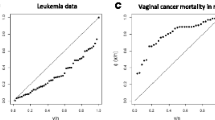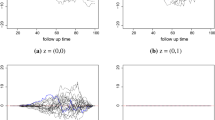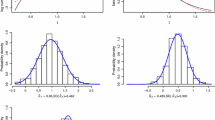Abstract
The hazard function, also called the risk function or intensity function, is usually used to model survival data or other waiting times, such as unemployment times. In contrast to the proportional hazard model, the additive risk model assumes that the hazard function is the sum of rather than the product of, the baseline hazard function and a non-negative function of covariates. We propose to introduce the covariates into the model through a Gamma hazard function, while the baseline hazard function is left unspecified. Following the Bayesian paradigm, we obtain an approximation to the posterior distribution using Markov Chain Monte Carlo techniques. The subject-specific survival estimation is also studied. A real example using unemployment data is provided.
Similar content being viewed by others
References
Aalen, O. O. (1980).A Model for Nonparametric Regression Analysis of Counting Processes, Springer-Verlag, New York.
Aalen, O. O. (1989). A linear regression model for the analysis of life times.Statistics in Medicine, 8:907–925.
Beamonte, E. (1998).Aportaciones al análisis bayesiano semiparamétrico de datos de supervivencia. Ph.D. thesis, Departmento de Estadística e Investigación Operativa, Universidad de Valencia.
Beenstock, M. (1996). Training and the time to find a job in Israel.Applied Economics, 28:935–946.
Best, N. G., Cowles, M. K., andVines, S. K. (1995).CODA manual version 0.30. MRC Biostatistics Unit, Cambridge.
Buckley, J. (1984). Additive and multiplicative models for relative survival rates.Biometrics, 40:51–62.
Casella, G. andGeorge, E. I. (1992). Explaining the Gibbs sampler.The American Statistican, 46:167–174.
Chib, S. andGreenberg, E. (1996). Markov Chain Monte Carlo simulation methods in Econometrics.Econometric Theory, 12:409–431.
Cox, D. R. (1972). Regression models and life tables (with discussion).Journal of the Royal Statistical Society, 34:187–220.
Cox, D. R. (1975). Partial likelihood.Biometrika, 62:269–276.
Cox, D. R. andOakes, D. A. (1984).Analysis of Survival Data. Chapman & Hall, London.
DeGroot, M. H. (1970).Optimal Statistical Decisions. McGraw-Hill, New York.
Follmann, D. A., Goldberg, M. S., andMay, L. (1990). Personal characteristics, unemployment insurance, and the duration of unemployment.Journal of Econometrics, 45:351–366.
Gamerman, D. (1991). Dynamic Bayesian models for survival data.Applied Statistics, 40:63–79.
Gelfand, A. E. andSmith, A. F. M. (1990). Sampling-based approaches to calculating marginal densities.Journal of the American Statistical Association, 85:398–409.
Geman, S. andGeman, D. (1984). Stochastic relaxation, Gibbs distributions, and the Bayesian restoration of images.IEEE Transactions on Pattern Analysis and Machine Intelligence, 6:721–741.
Geweke, J., Keane, M. P., andRunkle, D. E. (1998). Statistical inference in the multinomial multiperiod probit model.Journal of Econometrics, 80:125–165.
Gilks, W. R., Richardson, S., andSpiegelhalter, D. J., eds. (1996).Markov Chain Monte Carlo in Practice. Chapman & Hall, London.
Jaggia, S. andThosar, S. (1995). Contested tender offers: an estimate of the hazard function.Journal of Business & Economic Statistics 13:113–119.
Kim, J. andLee, S. Y. (1998). Two-sample goodness-of-fit tests for additive risk models with censored observations.Biometrika, 85:593–603.
Lin, D., Oakes, D., andYing, Z. (1998). Additive hazards regression with current status data.Biometrika, 85:289–298.
Lin, D. andYing, Z. (1994). Semiparametric analysis of the additive risk model.Biometrika, 81:61–71.
McKeague, I. andSasieni, P. (1994). A partly parametric additive risk model.Biometrika, 81:501–514.
Sinha, D. andDey, D. K. (1997). Semiparametric Bayesian analysis of survival data.Journal of the American Statistical Association, 92:1195–1212.
Smith, A. F. M. andRoberts, G. O. (1993). Bayesian computation via the Gibbs sampler and related Markov Chain Monte Carlo methods.Journal of the Royal Statistical Society, 55:3–23.
Tierney, L. (1994). Markov Chains for exploring posterior distributions (with discussion).Annals of Statistics, 22:1701–1762.
Author information
Authors and Affiliations
Corresponding author
Additional information
This work was partially supported by the Spanish Education and Science Council Project PB96-0776.
Rights and permissions
About this article
Cite this article
Beamonte, E., Bermúdez, J.D. A bayesian semiparametric analysis for additive Hazard models with censored observations. Test 12, 347–363 (2003). https://doi.org/10.1007/BF02595719
Received:
Accepted:
Issue Date:
DOI: https://doi.org/10.1007/BF02595719
Key Words
- Additive risk models
- Hierarchical models
- MCMC methods
- Non-proportional hazards
- Predictive distributions
- Survival data
- Unemployment data




